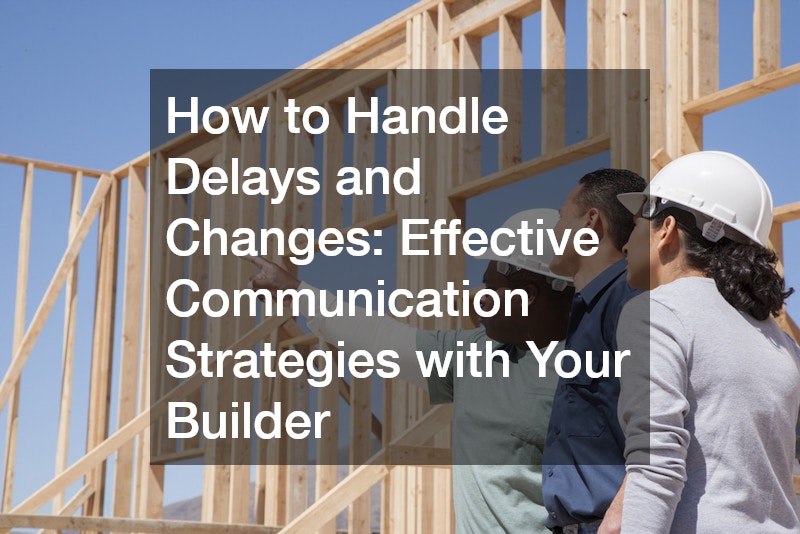-
Working with home builders with good communication keeps your project on track.
-
Set clear expectations early for updates, documentation, and emergency protocols.
-
Document all changes and timeline shifts to avoid misunderstandings.
-
Use technology like project management apps and photo updates for transparency.
-
Address conflicts professionally, focusing on facts and documented agreements.
-
Proactive communication reduces stress, protects budgets, and strengthens trust.
Building or renovating a home is an exciting but complex process. From coordinating contractors to selecting finishes and managing a timeline, homeowners face countless moving parts that can cause stress if not carefully managed. Even the most meticulously planned projects rarely go perfectly according to schedule, and unexpected delays or design changes are almost inevitable. These challenges can escalate quickly if there isn’t a clear communication strategy in place. Working with home builders with good communication ensures that potential issues are addressed proactively, and solutions are clearly explained.
Effective communication doesn’t just prevent frustration; it protects your budget, safeguards the project timeline, and ensures that your vision for the home is accurately executed. Homeowners who engage with builders known for strong communication practices experience smoother projects, more predictable outcomes, and better relationships with everyone involved, from subcontractors to suppliers.
Understanding Why Delays and Changes Happen
Delays and design changes are often unavoidable due to the complex nature of home construction. Every project has multiple contractors, strict regulations, and environmental variables that can impact schedules and plans. Even home builders with good communication encounter obstacles that require adjustments, and how these are handled makes a significant difference in the homeowner experience.
Construction delays can arise from several sources. Weather conditions such as heavy rain, extreme heat, or high winds may halt exterior work, affect concrete curing, or disrupt roofing installation. Supply chain challenges can delay the arrival of critical materials like flooring, cabinetry, or appliances, affecting the sequencing of work. Additionally, subcontractor scheduling conflicts or limited availability can result in temporary slowdowns. Permitting and inspection requirements imposed by local authorities can also introduce unforeseen delays if approvals take longer than anticipated.
Design changes occur for different reasons. Homeowners may decide to update finishes or layouts as the project progresses. Hidden structural issues, such as water damage or soil instability, can require modifications to ensure the home is safe and durable. Builders may recommend alternatives due to material availability, cost, or long-term functionality. Recognizing these causes allows homeowners to anticipate potential issues and approach delays and changes proactively rather than reacting under stress.
Setting Communication Expectations Early
One of the most important strategies for managing construction challenges is establishing clear communication expectations before work begins. Working with home builders with good communication means discussing not just what updates you will receive, but also how, when, and from whom. Setting these norms upfront avoids confusion, strengthens accountability, and ensures that all parties understand their roles in addressing potential issues.
-
Key considerations for establishing communication:
-
Preferred channels: Determine whether updates will come via email, phone calls, text messages, or project management software.
-
Update frequency: Decide whether progress reports should be weekly, bi-weekly, or based on project milestones.
-
Primary contacts: Identify who handles specific concerns, such as the project manager, designer, or site supervisor.
-
Documentation practices: Ensure that decisions, approvals, and change orders are recorded in writing to prevent misunderstandings.
-
Emergency protocols: Establish how urgent issues will be communicated, such as safety hazards, severe weather, or unexpected site damage.
-
By setting these expectations early, homeowners are better equipped to work effectively with builders known for their communication skills, making it easier to navigate delays or changes without stress.
Handling Timeline Shifts Effectively
Even with careful planning, construction schedules can shift. The key is maintaining proactive communication and understanding how delays affect different aspects of the project. Home builders with good communication excel at providing clear updates, outlining reasons for delays, and offering potential solutions to mitigate schedule disruptions.
-
Strategies for managing timeline shifts:
-
Request detailed explanations about the cause of the delay and the expected impact on subsequent work.
-
Maintain written records of revised schedules, including expected completion dates for each phase.
-
Discuss contingency plans to keep the project moving, such as adjusting the sequence of tasks or shifting work indoors when exterior conditions are unfavorable.
-
Prioritize critical tasks to prevent small delays from snowballing into larger scheduling issues.
-
Schedule regular check-ins to monitor progress, troubleshoot problems, and confirm next steps.
-
For example, if roofing installation is delayed due to high winds, a builder with strong communication might reschedule interior work, keeping subcontractors productive and preventing overall project delays. Clear, proactive updates reduce uncertainty and demonstrate the builder’s professionalism.

Managing Design Changes Without Stress
Design changes are a natural part of home construction, whether due to homeowner preferences, unforeseen structural requirements, or material substitutions. Managing these changes effectively requires thorough discussion, clear documentation, and transparency about costs and timelines. Homeowners who work with home builders with excellent communication are able to make informed decisions without unnecessary stress.
-
Effective strategies for design changes:
-
Use visual tools such as renderings, drawings, or digital mock-ups to clarify requested changes.
-
Review budget implications before approving modifications to prevent unexpected costs.
-
Document changes formally through signed change orders that outline the scope, cost, and revised timeline.
-
Discuss how changes may affect the overall project schedule and subcontractor availability.
-
Collaborate with the builder to explore alternative solutions when a proposed change is impractical.
-
Transparent communication ensures homeowners understand the trade-offs of any design change, helping maintain trust and alignment with their builder.
Navigating Unforeseen Obstacles
Unexpected challenges, such as hidden structural issues, supply shortages, or site complications, are common during construction. How these challenges are communicated can make the difference between a manageable situation and a stressful, costly problem. Choosing home builders with good communication guarantees that obstacles are addressed promptly, with clear explanations and actionable solutions.
-
Best practices for addressing unforeseen obstacles:
-
Request complete transparency about the nature of the issue, its impact on the project, and possible solutions.
-
Encourage solution-focused discussions, asking builders to provide multiple options with associated costs and timelines.
-
Maintain professional and calm dialogue, focusing on problem-solving rather than assigning blame.
-
Conduct frequent progress reviews to detect issues early, preventing minor problems from becoming major setbacks.
-
This proactive approach allows homeowners to stay informed, make timely decisions, and minimize the stress associated with unexpected challenges.
Tools and Methods for Effective Builder Communication
Technology can be a powerful ally in maintaining consistent communication throughout a project. Home builders with good communication often leverage tools and systems to streamline updates, manage tasks, and keep homeowners informed in real-time.
-
Communication tools to consider:
-
Project management software: Platforms like Buildertrend or CoConstruct allow for progress tracking, messaging, and schedule updates.
-
Shared calendars: Track milestones, inspection dates, and subcontractor schedules collaboratively.
-
Photo and video updates: Visual progress reports allow homeowners to monitor construction even when they cannot visit the site regularly.
-
Written meeting summaries: Capture decisions, approvals, and action items to prevent misunderstandings.
-
Cloud storage: Store contracts, plans, and change orders digitally for easy access and long-term reference.
-
Using these tools alongside regular check-ins ensures the project remains transparent and organized, helping both homeowners and builders stay aligned.
Conflict Resolution and Professional Communication
Even with the most communicative builders, disagreements can arise. How conflicts are addressed often determines whether a project remains on track or faces delays and additional costs. Professional communication strategies help maintain strong relationships and facilitate problem-solving.
-
Tips for resolving conflicts effectively:
-
Focus on the facts and documented agreements, separating issues from personalities.
-
Reference contracts, change orders, and previous communication to clarify expectations.
-
Schedule dedicated meetings to address disputes, rather than attempting to resolve issues informally during site visits.
-
Consider neutral third-party mediation for persistent or complex disagreements.
-
Maintain a professional, calm, and respectful tone to encourage constructive discussion and solutions.
-
By applying these strategies, homeowners can resolve conflicts efficiently while maintaining a positive and productive relationship with their builder.
Benefits of Proactive Communication
Proactive communication is one of the most valuable tools for homeowners during construction. Home builders with good communication provide transparency, guidance, and reassurance throughout the project, which reduces stress and keeps everything on track.
-
Reduces uncertainty by keeping homeowners informed about progress, challenges, and next steps.
-
Protects budgets by addressing issues early, before they escalate into costly problems.
-
Helps maintain schedules by ensuring all parties are aware of delays, changes, or obstacles.
-
Strengthens collaboration and trust between homeowners, builders, and subcontractors.
-
Creates a clear, documented trail of decisions and approvals, minimizing the risk of disputes.
Proactive communication transforms potential problems into manageable situations, making the home-building experience smoother and more enjoyable.
Delays, design changes, and unforeseen obstacles are inevitable in home construction, but they don’t have to derail your project. Working with home builders with good communication ensures that challenges are addressed proactively, explanations are clear, and solutions are presented professionally.
By establishing expectations early, documenting changes, using technology to stay organized, and maintaining professional dialogue, homeowners can navigate construction challenges effectively. Effective communication is not just about exchanging information—it is a strategic tool that protects budgets, timelines, and the overall success of a home-building project.
Choosing builders known for strong communication allows homeowners to feel confident, informed, and in control, even when unexpected changes occur, ultimately ensuring a successful and satisfying construction experience.
